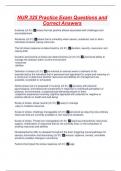NUR 325 Practice Exam Questions and
Correct Answers
Eustress (ch 31) ✅stress that has positive effects associated with challenges and
accomplishment
Allostress (ch 31) ✅stress that is unhealthy when severe, sustained, and or when
individual exhausts coping resources
The full stress response is determined by (ch 31) ✅duration, severity, resources, and
coping skills
Duration and severity of stress are determined by (3) (ch 31) ✅-perceived ability to
manage the stressor within current environment
-resources
-abilities
Definition of stress (ch 31) ✅the internal or external event or demand of life
experienced by the individual that is perceived and appraised for scope and meaning on
a continuum to determine whether resources and abilities for management are
available, exceeded or exhausted
Define stress (as it is proposed in nursing) (ch 31) ✅-process with physical,
psychological, and behavioral components in response to individuals perception of
physical, environmental, or psychosocial demands placed on them
-subjective experience involving cognitive appraisal with potential for negative or
positive effects on heatlh and well-being
Scope of stress: stress-neutral (ch 31) ✅-easy to manage
-easy to mobilize resources
Scope of stress: challenge manageable (ch 31) ✅perceived as requiring new ordinary
resources that are currently available or can easily be assessed
Scope of stress: Threat-non manageable (ch 31) ✅requiring extraordinary resources,
support, mobilization of resources that do not currently exist, or the exhaustion of
existing resources and abilities
Norepinepherine (NE) is released throughout the brain triggering neural pathways for
sensory information and stimulating (ch 31) ✅arousal, vigilance, anxiety, and labile
emotions (sudden changes in emotions)
Factors that impact the stress response (ch 31) ✅-age
, -developmental level
-maturation
-environmental
-life experiences
-the individual's general mental and physical health status
Sources of stress: physiological stressors refer to (ch 31) ✅stressor that originates as
a physiological trigger and usually is specifically associated with an injury or illness
Sources of stress: physiological stressors: examples (ch 31) ✅cancer, COPD,
dementia, diabetes, organ failure, MI, acute or chronic pain, traumatic injury
Sources of stress: psychological/emotional: basic definition (ch 31) ✅More common
stressors encountered on a regular basis and generate a state of unpleasant arousal
Sources of stress: psychological/emotional: examples (ch 31) ✅birth of child,
caregiving, change in health status, death of family, diagnosis of terminal illness,
divorce, environmental emergencies, failing an exam, loss of job, marriage, moral
distress, moving, parenting, physical disability, relationship problems, social unrest,
spiritual distress
Types of stress: acute stress (ch 31) ✅-most common type
-short period of time
-occurs in reaction to real or perceived demand, threat, or pressure
-resolution of stressor usually eliminates stress response
Types of stress: episodic acute stress (ch 31) ✅-"self inflicted"
-common in type A personalities
-often occurs by taking on unrealistic assignments beyond what is typically or
reasonably expected
-constant worry is another form
Types of stress: chronic stress (ch 31) ✅a perpetual or sustained demand, threat, or
pressure that is harmful to health because it wears on individuals continuously
-can stem from long-term stressors such as chronic occupational, financial, or
relationship stress
-often associated with loss of hope that the situation can improve
Consequences of chronic stress: CNS (ch 31) ✅cognitive function impairment
including
-headaches
-nervousness
-irritability
-problems with decision making
-insomnia




